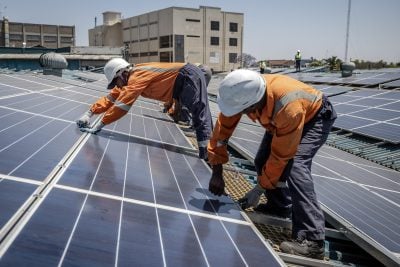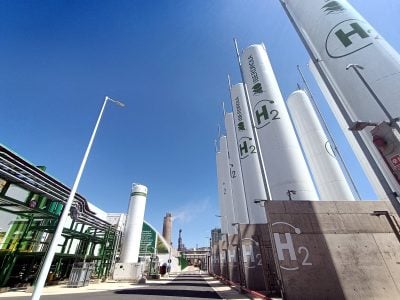Climb up high in Kampala and you will find yourself looking out across a sea of iron roofs. Zoom in, and you can see them being made. Steel coils, like enormous rolls of tape, arrive on trucks at the factory of Roofings Group in Namanve, on the edge of town.
There they are cleaned with acid and rolled to the right thickness – “like how you roll a chapati”, says an engineer – before being smoothed, trimmed, galvanised, colour-coated and corrugated.
Elsewhere in the factory, glowing hot billets are formed into long reinforcing bars, which poke from the concrete walls of half-completed buildings all over the city. Another part of the complex makes wire.
The story of Roofings, Uganda’s largest manufacturer of steel products, shows how a construction boom can generate manufacturing growth. The company was founded in 1994 by Sikander Lalani, a Ugandan Asian entrepreneur who trained as a histopathologist before leaving medicine for business.
In the 1970s he dealt in electronics and tyres in neighbouring Rwanda, and later started making roofing materials there. He relocated to Uganda after the 1994 Rwandan genocide, founding Roofings with a $2m investment and 60 employees. Today the company, which is still family-owned, boasts 1,850 permanent employees.
The original plant in Lubowa, just outside Kampala, has now been supplemented by the $180m rolling mill complex at the Kampala Industrial and Business Park in Namanve, where Roofings was the first business to start operations.
The latter project attracted funding from the International Finance Corporation, the private sector lending arm of the World Bank, as well as a 10% equity stake from the Japanese steel firms Yodogawa Steel Works and Fujiden International. That relationship helped with technology transfer.
“[The Japanese firms] have supplied us with equipment,” says Stuart Mwesigwa, business development manager at Roofings. “They are the ones who have trained our people in everything… At one time we had about 10 of them here, then we reduced to five, then two, then one. Now we don’t have any Japanese person around, because we have grasped the way they do things.”

Building up
The construction industry has grown rapidly in Uganda, and last year accounted for 5.5% of GDP. The government is investing in new infrastructure projects, such as dams across the Nile and oil development in the western region of Lake Albert. Meanwhile Ugandans with money would rather put it into hotels, malls and villas than in the bank.
Rising incomes and population growth are also fuelling demand from ordinary folk who build their own houses with whatever money they can save. One of the first home improvements that many people make is to buy iron sheets to replace thatch roofs, which are flammable and prone to wear and tear.
By 2017, 75% of Ugandan households had iron sheet roofs, up from 57% in 2000. While campaigning in northern Uganda before this year’s election, President Yoweri Museveni pointed to the number of houses with iron sheets as a sign that “things are beginning to move”.
The long construction boom has taken place against the backdrop of tepid manufacturing performance: there are more male Ugandans employed on building sites than in factories. But demand for construction materials can help stimulate industry, and companies like Roofings are the channel through which these multiplier effects flow.
In its plant at Namanve, Roofings does cold rolling, a step in the manufacture of iron sheets. “We started from the final product, that is the iron sheet, but we went on moving backwards,” says Mwesigwa.
The government wants to build an industry which encompasses the entire value chain, right back to the iron ore which is dug out of the ground in Kabale, in the southwest.
A 2018 report by the National Planning Authority (NPA) noted that two-thirds of Ugandan steel products are made from imported materials; most of the rest is made from scrap. In a 2020 study NPA researchers estimated that liquid steel production could be increased from 210,000 tonnes a year to 1.1m tonnes a year by 2024, with the right policies in place, though they also noted that only 35% of existing steel capacity is being used.
“Currently we import about $362m worth of steel products, and 70% of those are semi-finished products like coils and billets,” says Abraham Muwanguzi, science and technology manager at the NPA.
He sees potential for public-private partnerships between steel companies and the Uganda Development Corporation, a government agency, to invest in the smelting of iron and scrap. That would reduce the need for imported billets, but the plan faces challenges, from poor transport infrastructure to the lack of locally available reducing agents, like coal or natural gas.
At the other end of the chain, there is also demand for different kinds of products. All else being equal, “it’s cheaper to build a structure out of steel than concrete”, says Mark Kitaka, a structural engineer at Tetra Design and Concepts in Kampala. But materials such as I-beams, used as joists, are currently imported. The range is limited and taxes are heavy.
Chinese competition
Meanwhile Roofings is looking beyond Uganda to regional markets, which account for almost half of its sales.
The company already sells to Kenya, Tanzania, Rwanda, Burundi, the Democratic Republic of Congo and South Sudan. It has occasionally sold steel to Somalia, where the Ugandan army is part of a peacekeeping operation and needs material for tanks. The Eritrean president Isaias Afwerki has twice paid a visit to the Roofings factory, though Mwesigwa says supplying Eritrea is too logistically complicated at present.
Roofings is also building a new plant in Mombasa, on the Kenyan coast, on a site as large as its two Ugandan sites combined. Mwesigwa says the first phase is due to become operational this year, with plans to eventually export as far as Malawi.
But just as Roofings is eyeing foreign markets, outside players are targeting Uganda.
“It is difficult for us to compete with the imports from China, imports from Egypt, because of the economies of scale,” says Mwesigwa. “They have incentives to support manufacturing. They have incentives to support exports. So for us here as an infant [industry] in a less-developed country, our costs are so much.”
One new entrant that is shaking up the Ugandan market is Tian Tang, a Chinese group with interests in steel, hotels, real estate, mining, machinery, plywood and mattresses, which has developed its own industrial parks in the central district of Mukono and the eastern city of Mbale.
Kitaka, the engineer, says that established firms like Roofings and Steel & Tube have good reputations, but some newcomers “have a quality issue” with their products. “Because the National Bureau of Standards is not very stringent we have people producing low-grade steel and selling it as high-grade steel,” he says.
Continental ambition
While acknowledging that “competition is healthy”, Mwesigwa also accuses rivals of cutting regulatory corners to save on costs. “If we allow those who are already developed to come and blindfold us and pretend to be doing clean business then in fact manufacturing entities like Roofings and so many other companies will never grow.”
Even so, Mwesigwa is confident that Roofings can ward off the competition. “Our chairman [Lalani] is so focused, he has a vision,” he says. “We want to become a continental brand.”
Want to continue reading? Subscribe today.
You've read all your free articles for this month! Subscribe now to enjoy full access to our content.
Digital Monthly
£8.00 / month
Receive full unlimited access to our articles, opinions, podcasts and more.
Digital Yearly
£70.00 / year
Our best value offer - save £26 and gain access to all of our digital content for an entire year!
 Sign in with Google
Sign in with Google 



